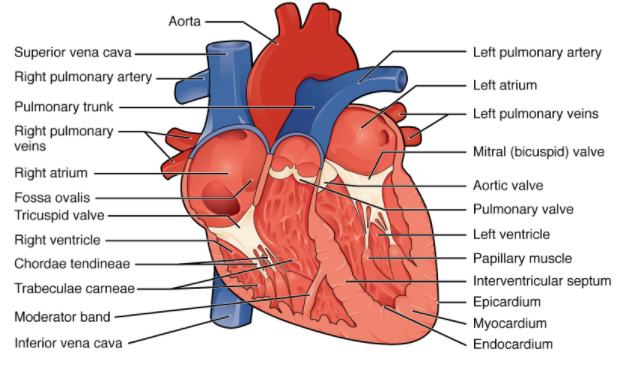
Draw a labelled diagram of the internal structure of the human heart.
Answer
469.8k+ views
Hint: The human heart is an organ that pumps blood across the body through the circulatory system, provides oxygen and nutrients to the tissues, and eliminates carbon dioxide and other waste.
Complete answer:

In humans, the heart is approximately the size of a large fist and weighs about 10 to 12 ounces (280 to 340 grams) in males and 8 to 10 ounces (230 to 280 grams) in females.
The human heart has four chambers: two upper chambers (the atria) and two lower chambers (the ventricles). The right atrium and the right ventricle together cover the "right heart," and the left atrium and the left ventricle cover the "left heart." The muscle wall called the septum divides the two sides of the heart.
The heart is encased in a double-walled sac called the pericardium, which covers the heart and anchors it within the chest. Pericardial fluid, which lubricates the heart during contractions and movements of the lungs and diaphragm, flows between the outer layer, the parietal pericardium, and the inner layer, the serous pericardium. The outer wall of the heart consists of three layers. The outer wall layer, or epicardium, is the inner wall of the pericardium. The middle layer, or myocardium, includes the muscle that connects. The inner layer, or endocardium, is the liner that is in contact with the blood.
The right atrium receives venous blood from the head, chest, and arms through a large vein called the upper vena cava and receives blood from the abdomen, pelvic area, and legs through the lower vena cava. Blood passes through the tricuspid valve to the right ventricle, which propels it through the pulmonary artery to the lungs. In the lungs, venous blood comes into contact with inhaled air, takes up oxygen, and loses carbon dioxide. Oxygenated blood is returned through the pulmonary veins to the left atrium. The valves in the heart allow the blood to flow in one direction only and help maintain the pressure needed to pump the blood.
Note: The heart beats about 100,000 times a day (about 3 billion beats in a lifetime).
The adult heart beats about 60 to 80 times a minute.
The hearts of Newborns beat faster than the hearts of adults, between 70 to 190 beats per minute.
Around 5.7 litres of blood is pumped around the body by the heart.
The heart is in the middle of the chest, usually slightly to the left.
Complete answer:

In humans, the heart is approximately the size of a large fist and weighs about 10 to 12 ounces (280 to 340 grams) in males and 8 to 10 ounces (230 to 280 grams) in females.
The human heart has four chambers: two upper chambers (the atria) and two lower chambers (the ventricles). The right atrium and the right ventricle together cover the "right heart," and the left atrium and the left ventricle cover the "left heart." The muscle wall called the septum divides the two sides of the heart.
The heart is encased in a double-walled sac called the pericardium, which covers the heart and anchors it within the chest. Pericardial fluid, which lubricates the heart during contractions and movements of the lungs and diaphragm, flows between the outer layer, the parietal pericardium, and the inner layer, the serous pericardium. The outer wall of the heart consists of three layers. The outer wall layer, or epicardium, is the inner wall of the pericardium. The middle layer, or myocardium, includes the muscle that connects. The inner layer, or endocardium, is the liner that is in contact with the blood.
The right atrium receives venous blood from the head, chest, and arms through a large vein called the upper vena cava and receives blood from the abdomen, pelvic area, and legs through the lower vena cava. Blood passes through the tricuspid valve to the right ventricle, which propels it through the pulmonary artery to the lungs. In the lungs, venous blood comes into contact with inhaled air, takes up oxygen, and loses carbon dioxide. Oxygenated blood is returned through the pulmonary veins to the left atrium. The valves in the heart allow the blood to flow in one direction only and help maintain the pressure needed to pump the blood.
Note: The heart beats about 100,000 times a day (about 3 billion beats in a lifetime).
The adult heart beats about 60 to 80 times a minute.
The hearts of Newborns beat faster than the hearts of adults, between 70 to 190 beats per minute.
Around 5.7 litres of blood is pumped around the body by the heart.
The heart is in the middle of the chest, usually slightly to the left.
Recently Updated Pages
Can anyone list 10 advantages and disadvantages of friction

What are the Components of Financial System?

How do you arrange NH4 + BF3 H2O C2H2 in increasing class 11 chemistry CBSE

Is H mCT and q mCT the same thing If so which is more class 11 chemistry CBSE

What are the possible quantum number for the last outermost class 11 chemistry CBSE

Is C2 paramagnetic or diamagnetic class 11 chemistry CBSE

Trending doubts
Which is not a source of freshwater 1 Glaciers and class 11 chemistry CBSE

10 examples of friction in our daily life

The correct order of melting point of 14th group elements class 11 chemistry CBSE

Difference Between Prokaryotic Cells and Eukaryotic Cells

One Metric ton is equal to kg A 10000 B 1000 C 100 class 11 physics CBSE

What is the specific heat capacity of ice water and class 11 physics CBSE




